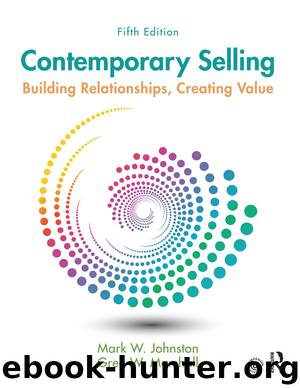Contemporary Selling by Johnston Mark W. Marshall Greg W. & Greg W. Marshall

Author:Johnston, Mark W.,Marshall, Greg W. & Greg W. Marshall [Mark W. Johnston]
Language: eng
Format: epub
ISBN: 9781317360810
Publisher: Taylor & Francis Ltd
Summary
No matter how well a salesperson prepares or presents the material to the customer—indeed, despite everything the salesperson does—the customer will seldom (if ever) buy a product based only on the presentation. Customer objections are part of the relationship-building process, and negotiating win-win solutions separates successful salespeople from the rest of the pack. Negotiations are the process of arranging with customers (through conference, discussion, and compromise) a successful resolution to their concerns.
While there may appear to be many different customer concerns, in reality there are only five. The first is “Do I need your product?” There are two types of product concerns. First, the customer needs to be convinced he or she needs the product at all. Second, the customer may already use the product but buy it from a competitor. You need to convince the customer that your product is demonstrably better than the competition.
The second fundamental customer concern is “Do I trust your company?” Customers may not know your company and doubt your ability to deliver what, when, and where they require. Or they may have a good relationship with their current supplier and see no reason to change companies. In both cases, you need to work hard to show customers that your company is fundamentally capable of handling their orders and is better than the competition.
A third customer objection has to do with the salesperson—“I don’t really know you?” Customers may need to be persuaded that trusting you is not risky. A fourth concern is “I need more time to consider your product.” While there can be legitimate reasons why the customer needs more time, this is often an attempt to stall the purchase decision. The customer may be saying, “You have not yet made a strong value proposition and I don’t fully understand the value of your product relative to the competition.”
The final customer concern is “Is this your best price?” Customers often focus on price to the exclusion of other, more critical factors. The salesperson’s job is to help the customers understand the value of the total benefits package and focus on issues other than price.
There are six basic points to consider in preparing to negotiate win-win solutions: (1) plan and prepare, (2) anticipation enhances negotiations, (3) say what you mean and mean what you say, (4) negativity destroys negotiations, (5) listen and validate customer concerns, and (6) always value the value proposition. Following these guiding principles greatly improves the probability of success in negotiations.
The nine basic negotiating strategies are (1) question, (2) direct denial, (3) indirect denial, (4) compensating for deficiencies, (5) feel—felt—found, (6) third-party endorsement, (7) bounce-back, (8) defer, and (9) trial offer. Knowing when and where to use each strategy is critical. Using the wrong one at the wrong time (such as the direct denial) can create very negative feelings in a customer.
Finally, the sales manager plays a significant supporting role. First, he or she empowers salespeople to negotiate with customers. If customers don’t believe salespeople have the authority, they will not negotiate.
Download
This site does not store any files on its server. We only index and link to content provided by other sites. Please contact the content providers to delete copyright contents if any and email us, we'll remove relevant links or contents immediately.
Bad Blood by John Carreyrou(6581)
Rich Dad Poor Dad by Robert T. Kiyosaki(6513)
Principles: Life and Work by Ray Dalio(6296)
Playing to Win_ How Strategy Really Works by A.G. Lafley & Roger L. Martin(6082)
Management Strategies for the Cloud Revolution: How Cloud Computing Is Transforming Business and Why You Can't Afford to Be Left Behind by Charles Babcock(4546)
The Confidence Code by Katty Kay(4220)
Thinking in Bets by Annie Duke(4184)
American Kingpin by Nick Bilton(3817)
Delivering Happiness by Tony Hsieh(3394)
Project Animal Farm: An Accidental Journey into the Secret World of Farming and the Truth About Our Food by Sonia Faruqi(3189)
The Power of Habit by Charles Duhigg(3093)
The Tyranny of Metrics by Jerry Z. Muller(3028)
Brotopia by Emily Chang(3026)
Mastering Bitcoin: Programming the Open Blockchain by Andreas M. Antonopoulos(3010)
The Marketing Plan Handbook: Develop Big-Picture Marketing Plans for Pennies on the Dollar by Robert W. Bly(3005)
I Live in the Future & Here's How It Works by Nick Bilton(2959)
The Content Trap by Bharat Anand(2887)
Applied Empathy by Michael Ventura(2864)
Building a StoryBrand by Donald Miller(2862)
